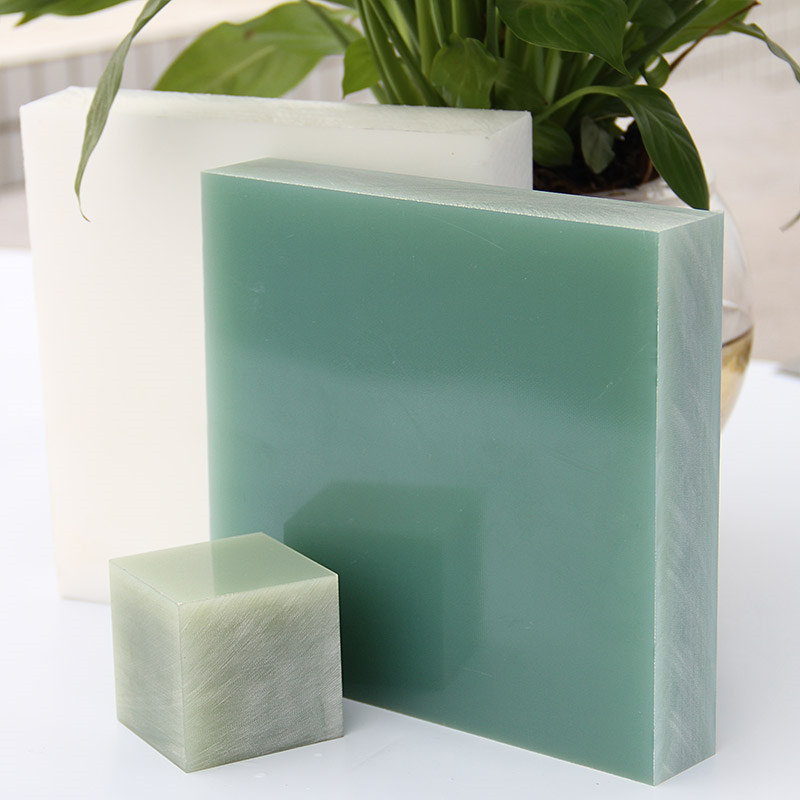FR-4 classification:
The surface colors of FR-4 epoxy glass cloth laminate are include:Yellow FR-4, white FR-4, black FR-4, blue FR-4, etc.
FR-4 is a type of sheet and used for PCB as the substrate. According to the different of reinforcement materials, the FR4 sheets are mainly classified into the following four types:1) FR-4: glass cloth substrate
2) FR-1, FR-2, etc.: paper substrate
3) CEM series: composite substrate
4) Special material substrate (ceramic, metal base, etc.)
FR-4 is a laminate board that obtained by immersing epoxy resin with alkali-free glass fiber cloth by pressing under high-temperature and high-pressure,it’s rigid insulating laminated sheet.
Features: High mechanical and dielectric properties, good heat and moisture resistance and good machinability.
Uses: Insulation structural parts in motors and electrical equipment, including various types of switches FPC reinforced, electrical insulating carbon film printed circuit boards, computer drilling mat mold fixtures (PCB test racks) and in humid environmental conditions and Used in transformer oil.
Basic characteristics:
No. | Test Item | Test condition | Unit | Standard Value | Testing Result |
1 | Density | ISO 1183 | g/cm3 | ≥1.70 | 1.85 |
2 | Moisture Absorption (0.125”) | ASTM D-570 | % | 0.15 max | 0.10 |
3 | Breakdown Voltage Condition A | ASTM D-149 | kV | 45 min | 66 |
4 | Permittivity @ 1 MHz Condition A | ASTM D-150 | ‐‐ | 5.2 max | 4.4 |
5 | IZOD Strength (0.062”) Length-Wise | ASTM D-229 | ft-lb/in | 7.0 min | 13 |
6 | Flexural Strength (0.062”) Length-Wise | ASTM D-790 | ksi (MPa) | 60.0 (414) min | 80 (552) |
7 | Flexural Modulus (0.062”) Length-Wise | ‐‐ | ksi (GPa) | ‐‐ | 2,900 (20) |
8 | Tensile Strength (0.125”) Length-Wise | ASTM D-638 | ksi (MPa) | ‐‐ | 62 (430) |
9 | Compressive Strength, Flat-Wise (0.500”) | ASTM D-695 | ksi (MPa) | ‐‐ | 66 (455) |
10 | Bonding Strength (0.500”) Length-Wise | ASTM D-229 | Lb (kg) | 2000 (907) min | 2,500 (1,133) |
11 | Shear Strength (punch type, 0.062”) | ASTM D-732 | psi (MPa) | ‐‐ | 21,500 (148) |
12 | Temperature Index | ASTM D-2304 | ℃ | ‐‐ | 130 |
13 | Coe cient of Thermal Expansion | ASTM E-228 | '/''℃x10-6 | ‐‐ | 15 |
14 | Flammability Rating | UL94 | Class | V-I | V-0 |
15 | Dissipation Factor @ 1 MHz Condition A | ASTM D-150 | ‐‐ | 0.025 max | 0.014 |
16 | Dielectric Strength (Condition A) | ASTM D-149 | V/mil | ‐‐ | 635 |
17 | Arc Resistance (0.125”) | ASTM D-495 | Sec | ‐‐ | 140 |
18 | Comparative Tracking Index (0.125”) | ASTM D-3638* | V | ‐‐ | 230 |
Process characteristics:
(1) FR-4 process platen melting point (203 ℃)
(2) High resistance
(3) Low loss factor (Df 0.0025)
(4) Stable and low dielectric constant (Dk 2.35)
(5) Thermoplastic materials
What is FR-4?
FR-4 is a code name of a flame-resistant material grade. It means a material specification that the resin material must be self-extinguishing after being burned. It is not a material name, but a material grade, so the current general circuit is used by many types of FR-4 grades,but most of them are made of Tera-Function epoxy with filler and glass fiber.
FR-4 Epoxy Glass Cloth Laminate,according to the industry applications,also known as FR-4 Epoxy Glass Cloth,Insulation Board,Epoxy resin Board, Brominated Epoxy Board, FR-4 , fiberglass board, FR-4 reinforcing board, FPC reinforcing board, flexible circuit reinforcing board, FR-4 epoxy board, flame retardant insulation board, FR-4 laminated board, epoxy board , FR-4 light board, FR-4 glass fiber board, epoxy glass cloth board, circuit board drilling pad.
Main technical features and applications:
Electrical insulation Stable, good flatness,smooth surface,standard thickness tolerance.
Suitable for high-performance electronic insulation requirements, such as FPC reinforcement board, PCB drilling Pad, glass fiber meson, potentiometer carbon film printing fiberglass board, precision star gear (wafer grinding), precision test board, electrical (electrical) equipment insulation struts, insulation pads, transformer insulation board, motor insulation , grinding gears, electronic switch insulation boards, etc.
JY Machinery is a professional manufacturer of CNC Machining for insulating materials. Its main products are:epoxy fiberglass laminated sheet/rod/tubing(FR-4,G-10,3240,FR5,G11),Phenolic laminated(Paper&Cotton) and GPO-3,etc
We have introduced many imported advanced processing equipments and have a scientific management system.All products are in line with SIO9001,SGS and RoHS certification standards. JY Machinery's integrity, strength and product quality have been recognized by the industry. Welcome all friends come to visit, guide and negotiate business. Email: info@jycncmachining.com
评论
发表评论